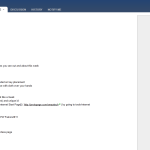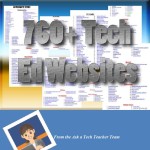September 25, 2012
What’s a Digital Portfolio and Why Should You Use it?
 The feedback on Otto’s answer to Mary’s question about which digital portfolio to use with her students was tremendous. Clearly, it’s a topic on people’s minds. Here’s a thorough discussion of this including what ‘digital portfolios’ are and why you should be using them:
The feedback on Otto’s answer to Mary’s question about which digital portfolio to use with her students was tremendous. Clearly, it’s a topic on people’s minds. Here’s a thorough discussion of this including what ‘digital portfolios’ are and why you should be using them:
By fifth grade, students have lots of school work that needs to be 1) saved for future use, 2) accessed from home and school, 3) shared with multiple students for collaborations, 4) linked to other pieces of work or online sites. For example, a student can create a project summary at school, access it at home and link key words to websites found by a classmate that supports the project discussion. As an educator, you might have goals for your class that aren’t adequately fulfilled by network file folders or binders on a shelf in the classroom. You might be looking for ways to 1) help students become more reflective about themselves as learners, 2) demonstrate evidence of student growth and achievement, 3) inform instruction, influence practice, and set goals, 4) learn about your students, and 5) help students see technology as a tool rather than an end to itself.
This can all be accomplished with Digital Portfolios—also known as digital lockers or e-portfolios—electronic collections of student work that provide evidence that the student is meeting a set of goals.
The concept of digital portfolios is supported by national and international education pedagogy: 1) ISTE makes it important to “interact, collaborate, and publish with peers…” and “contribute to project teams to produce original works or solve problems”, 2) the International Baccalaureate PYP program requires a digital portfolio be maintained throughout the student PYP school years, and 3) Common Core State Standards considers collaboration and publishing fundamental to accomplishing educational goals.
If you’re new to digital portfolios, here are some Guidelines for Developing a Digital Portfolio Program from Todd Bergman, an educator who’s helped hundreds of students create portfolios
- Be realistic about your design and expectations.
- Make use of relevant models.
- Instill a sense of ownership in students creating the portfolios.
- Communicate implementation strategies and timelines clearly.
- Be selective in design and strategy.
- Allow for continuous improvement and growth.
- Incorporate assessment stakeholders in all phases and components of your efforts; that is, make sure portfolio content meets the needs of those assessing the work.
- There are a variety of approaches to creating digital portfolios for fifth graders: 1) use file folders set aside on the school’s network, 2) use fee-based software provided by companies such as Richer Picture, 3) use free online wikis. We will use a wiki—an online storage location/webpage with a dedicated page for each student.
- Most students are familiar with ‘Wikipedia’ but few know they can join and edit this popular online encyclopedia. Wikis are websites edited ‘by the people’. What’s that mean for credibility?
- Explain how the wiki pages we will use are secure and private. Circle back on previous discussions about digital citizenship, digital security and digital footprints (more on this webpage). Discuss this with students. Answer any questions they may have.
- There are a variety of wiki providers. Among them: 1) Wikispaces, and 2) PBWorks. We’ll use Wikispaces.
- Set up a Wikispace main account for each fifth grade class. Include information on (click for an example of my 5th grade wiki):
- What is a Wiki
- What are this Wiki’s rules
- What does each student agree to when s/he uses this wiki
- How do students get started
- How do students use a Wiki as a Digital Portfolio
- Where can users get help
- Where are Student resources
- Where can students find their pages
- Where can students find Announcements
- Is there a place for ‘Extras’
- Take most of one 45-minute class to introduce students to wikis, get them set up with Wikispaces and joined into the class wiki. Allow it to be student-directed as much as possible. Ask them to read the screen, and try to find solutions before asking for assistance. Most problems can be figured out with the application of brain power.
- Have students create their own page. Use a template you’ve created (I call mine ‘student template’) which includes the layout and critical information you want included. These might be: 1) an avatar, 2) headings for each project, 3) a Table of Contents, and 4) whatever else you want to highlight for your class.
- Remind students to always use good grammar and spelling on anything going on the internet. This is part of their digital footprint (circle back on prior discussions of this topic) and they want that as impressive as possible.
- Once students have created their page, have them link it to the generic ‘student page’ link on the class wiki so it’s easy to locate.
- Now it’s time to work on their digital portfolio. Start by personalizing it.
- Create an avatar using an online avatar creator (Clay yourself, a monster, Lego you, Wild animal, Make me a hero, MadMen yourself). Take a screen shot and upload it to the student wiki page. Demonstrate how students edit their page and then expect them to accomplish it.
- Next, create Vokis as an introduction to viewers of their wiki page. Provide guidelines as to what the Voki should say that fits your class. Show students how to use Wikispaces embed tool to place the interactive avatar on their website.
- Finally, create a Tagxedo discussing what students think about technology, what tools they’re excited to learn, or maybe just a profile of themselves in word cloud format. When they’ve entered their words, picked their shape and fonts, show them how to ‘share’ by grabbing the embed code to insert into their Wiki page.
- When these beginning steps are accomplished, give students time to visit each other’s wiki pages and listen to the Voki greetings. Encourage them to leave comments using the Discussion tab.
- Throughout the year, students will post their projects, both ongoing and finished. In some cases, they will collaborate with other students. Other times, they’ll solicit feedback or reflect on what they have accomplished. It will vary with projects and you as the teacher will guide them with these goals.
- Several times throughout the year, review portfolios in a more formal manner. There are several rubrics available (here and here or Google ‘eportfolio rubrics’) or create one that covers your particular needs.
Extension: Here’s an example of my fifth grade wiki.
Trouble shooting: I can’t get logged in If student can’t remember their log-in information, they can request it be sent to them or set up a new Wikispaces account and rejoin the class wiki. The former takes hours. The latter takes minutes. I’ve found it much easier to simply create a new account. Students can then edit their pages using the new log-in.
–copied with permission from THE KEY TO ALIGNING YOUR K-5 CLASS WITH COMMON CORE STATE STANDARDS 30 Projects that integrate technology into core lesson plans
Jacqui Murray is the editor of a K-6 technology curriculum, K-8 keyboard curriculum, creator of two technology training books for middle school and six ebooks on technology in education. She is the author of Building a Midshipman, the story of her daughter’s journey from high school to United States Naval Academy. She is webmaster for six blogs, an Amazon Vine Voice book reviewer, a columnist for Examiner.com, Editorial Review Board member for Journal for Computing Teachers, Cisco guest blog, Technology in Education featured blogger, IMS tech expert, and a bi-weekly contributor to Write Anything. Currently, she’s editing a thriller that should be out to publishers next summer. Contact Jacqui at her writing office or her tech lab, Ask a Tech Teacher.






